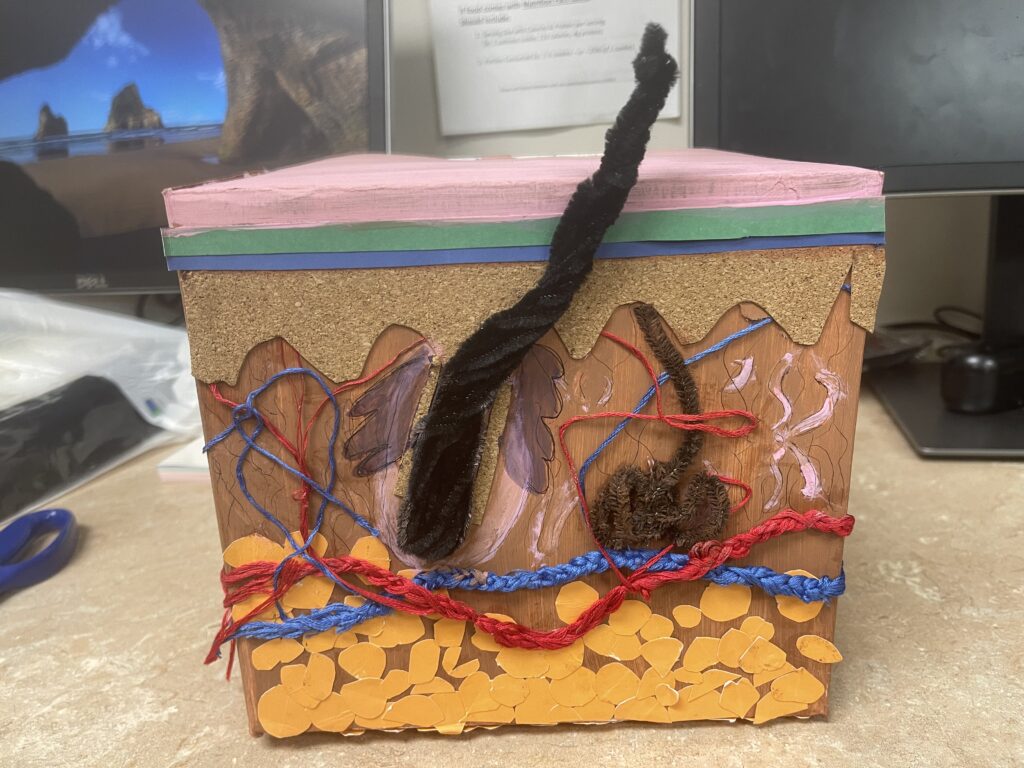The Integumentary system and how some of the epithelial and connective tissues and cells are affected by aging.
Markita Matthews
My Project is on the integumentary system and how some of the connective and epithelial tissues and cells are affected as you age. The integumentary system is made of multiple layers of cells and tissues that are held together by underlying structures of connective tissue. The top layer of the skin is the epidermis which consists of a highly organized, continuously renewing squamous epithelium that is stratified into functionally distinct layers: stratum basale, stratum spinosum, stratum granulosum, and stratum corneum (Mauldin, E. A., & Peters-Kennedy, J. (2016). Integumentary system) The cells in all of the layers except the stratum basale are called keratinocytes. Keratin is a fibrous protein that gives hair, nails, and skin their hardness and water-resistant properties. The dead keratinocytes in the stratum corneum are shed away, and get replaced by cells of the deeper layers. So the bottom layer consists of cuboidal cells, whereas the outer layers are squamous and keratinized cells. The epidermis’ main purpose is to protect the underlying tissues from physical damage, pathogens, and UV light. In my project I tried to show in my model that, as you age the epidermis thins, there’s changes in the connective tissues reducing the skin’s elasticity.
The Dermis contains the blood, lymph vessels, nerves, hair follicles and the sweat glands. It’s made of two layers of connective tissue that form a mesh of elastin and collagenous fiber (Parrish, A. R. (2017). The impact of aging on epithelial barriers). The layers are the papillary layer that’s made of loose areolar connective tissue. And the Reticular layer which is made up of dense irregular connective tissues that is well vascularized and adequate nerve supply. In the dermis I tried to show how the veins and arteries thin or narrow and decrease circulation and blood flow also in the normal skin model I drew in many nerves and collagen fibers but in the aged model there’s not as many nerve endings or collagen fibers because the older you get these things decrease and the fiber loss also contributes to sagging and wrinkling skins. Also in my model the Sebaceous glands are a little bit smaller in size on the aged model of the integumentary system, because as the sebaceous glands produce less oil as you age This makes it harder to keep the skin moist, resulting in flakes and dryness. The sweat glands produce less sweat or reduced sweat gland activity. This makes it harder to keep cool. Your risk for overheating or developing heat stroke increases.
The hypodermis is the last and deepest layer of the integumentary system and it’s kind of hard to see the difference between that and the dermis. The Hypodermis is formed of well vascularized loose areolar connective tissues and adipose tissue. In my model the subcutaneous layer of fat or the Adipose connective tissue thins so the body has less insulation and padding. This reduces your ability to maintain body temperature. Because you have less natural insulation making it harder to hang on to heat. Due to hormone changes and levels as you get older, in the model I tried to show a thinner hair follicle and root and also the hair is now gray.
Effects of Aging on the Integumentary System (pharmacy180.com)
The impact of aging on epithelial barriers: Tissue Barriers: Vol 5, No 4 (tandfonline.com)
Parrish, A. R. (2017). The impact of aging on epithelial barriers. Tissue Barriers, 5(4), e1343172. https://doi.org/10.1080/21688370.2017.1343172
Integumentary System – PMC (nih.gov)
Mauldin, E. A., & Peters-Kennedy, J. (2016). Integumentary system. Jubb, Kennedy & Palmer’s Pathology of Domestic Animals: Volume 1, 1, 509-736.e1.
Anatomy of the Integumentary System | SpringerLink
Koeppen, B. M., & Niekrash, C. E. (2020). Anatomy of the Integumentary System. Applied Head and Neck Anatomy for the Facial Cosmetic Surgeon, 65–72.



As a person gets older the epidermis begins to thin and the connective tissue is reducing its elasticity. The Dermis is made of two layers of connective tissue that form the elastin and collagenous fiber. This contains blood, lymph vessels, nerves, hair follicles, and sweat glands as shown in the project. The area that gets impacted the most by the person’s aging is the epithelial barrier. The project illustrates how someone with youthful skin nerve and collagen is more present compared to an older person where the nerve endings and collagen fibers have decreased and or been lost. The loss of collagen fibers is why the skin begins to sag and wrinkle. Also shows that the sebaceous gland shrinks as we get older because less sweat is being produced which in turn makes it hard to keep cool. Hypodermis is the deepest layer of the integumentary system and is formed from vascularized loose areolar connective tissue and adipose tissue. In the model, it shows on the older skin that the subcutaneous layer of adipose connective tissue is thin showing it going to be less insulation making it harder for the body to maintain its temperature. This model does a great job of giving a visual of what our skin is going through as we begin to get older.